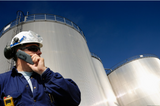Blog
Catalytic Gas Detector: How Catalytic Bead Sensors Work and Why O2 Sensors Are Important
Confined spaces found in refineries, chemical plants, and mines, may contain toxic and combustible gases and lack a safe level of oxygen. Inspecting and working in these types of spaces requires reliable gas detection in order to stay safe and be aware of any danger before entering, and knowing when to ventilate or evacuate. A lot of our customers look for the highest level of protection combined with the lowest cost of ownership. The solution can come down to choosing a catalytic bead or a n
…
Oct 3rd 2017
OSHA Says Attics and Crawl Spaces Require 4-Gas Monitors
Plumbers, electricians, carpenters, HVAC techs and many other tradesmen find themselves crawling around attics and crawlspaces on a regular basis. Now they are going to need to bring one more piece of equipment with them - a
personal 4-gas monitor. OSHA has recently clarified their standard concerning these very routine work areas and they are officially now classified as confined spaces.
Confined spaces are inherently dangerous, and OSHA's not unreasonable response is to require add
…
Feb 19th 2016
Draeger Accruo Pump Provides Simple Gas Detection in a Complex World
The
Accuro manual hand pump from Draeger is used in an incredibly wide range of industries for gas detection. Scuba divers use it to test the air from their pumps for carbon monoxide (CO), carbon dioxide (CO2), oil mist, and water vapor. Submariners use it to measure oxygen (O2), carbon dioxide, and hydrogen (both 0-2000 ppm and 0 - 4% LEL).
More often this versatile, non-electric bellows-style pump is used in industrial plants and factories to provide quick, reliable readings of eve
…
Aug 21st 2015
Draeger X-zone 5000 - The Best of Fixed and Portable Gas Monitoring
The
X-zone 5000 from Draeger is designed to get workers out safely in the event of an accident. It combines the best of fixed and portable gas detection technology into a wireless and modular defense system against dangerous gas leaks.
Draeger has been the company that people who are serious about gas detection and safety have turned to for many years. The X-zone 5000 is another in a long line of innovative safety devices that uses cutting edge communications technology combined with
…
Aug 7th 2015
Gas Sensors: How Do Gas Monitor Sensors Work?
The sensors in your gas monitor work in different ways to keep you safe. Some wear out relatively quickly, while others could conceivably last forever. Here is a very quick overview to help you understand basic gas sensor technology. We hope this information will allow you to see the benefits of regular maintenance, bump testing and
calibration.
The most common sensors used in confined space work are Oxygen, % LEL (Lower Explosive Level), Carbon Monoxide, and Hydrogen Sulfide. Howeve
…
May 2nd 2015
Confined Space Gas Limits: The Importance of Gas Monitoring in Confined Spaces Pt. 2
The second in a two-part series on confined space gas monitoring:
They say that knowledge is power. This is certainly the case when it comes to safety in confined spaces. It is only after we are aware of the potential dangers of confined spaces that we can recognize a seemingly empty space as containing life-threatening possibilities.
BW Honeywell GasAlert Micro Clip XL 4-Gas Monitor
In the first part of our Gas Monitoring discussion, we talked about Oxygen (O2) levels and Lower Explosi
…
Feb 27th 2015
Product Review: BW Honeywell Gas Alert Max XT II 4 Gas Monitor
The
BW GasAlert Max XT II is a humdinger of a detector, both for its ease of usage and reasonable price. In my opinion, this is the best gas detector to buy if you’re entering a confined space or septic tank. This one button unit makes it perfect for both the glove crowd and the technologically challenged. Plus, its simple operation makes tampering with its functions nearly impossible (a helpful feature if you want to ensure that you crew doesn’t decide to change any o the setting without
…
Dec 26th 2014
How to Measure Confined Space Gases
Gas measurement is without a doubt the most important part of confined space safety.
Do it right, and you and your crew go home at the end of the day—do it wrong, and you might never go home again! So if you're a newbie (or even a little rusty), you've got to do your homework.
Here's the first lesson: get the right tools! If you already have a gas monitor, take it out and look at it. Without this device you are nothing! It always has to be with you in any confined space — no excuses! But m
…
Dec 5th 2014
Oil & Gas Facilities Moving Toward Multi-Gas Monitors
As oil and gas production continues to expand in the United States and other countries, many companies are seeing the benefit of personal gas monitors that check for more than just hydrogen sulfide. Refineries, processing plants, pipelines, storage farms, and offshore platforms all use or create a wide range of toxic gases and dangerous atmospheres. While single gas monitors like the
BW Clip 3-Year Detector H2S are ubiquitous, they aren't capable of warning workers of all the changing cond
…
Apr 7th 2014
How to Purge and Test Natural Gas Mains Using RKI's GX-2012
Crews tackling installation or replacement of natural gas mains need to purge the lines with an inert gas to eliminate the combustion hazard. Purge testing before work begins requires a gas detection device that won't be overwhelmed or damaged by the high gas levels found in this type of work. It's also important to realize that many gas detection sensors require oxygen for accurate measurements.
Nitrogen is the gas most often employed to displace the natural gas when servicing main lin
…
Jul 18th 2013











